
In the world of science fiction, the notion that humanity will one day connect our brains together into a global “hive mind” dates back to a 1930 novel entitled “Last and First Men” by Olaf Stapledon. It recounts a fictional “future history” in which humanity evolves biologically into a species that can link telepathically into collective minds of extreme intelligence.
In the real world this pursuit is called Collective Superintelligence and it will not require telepathy or other fictional devices. Instead, it will use Generative AI technologies to connect large human groups into real-time deliberative systems, enabling us to solve difficult problems by harnessing our combined knowledge, wisdom, and insight in powerful new ways.
This has been the driving goal of Unanimous AI for the last decade and we believe it has the potential to produce super-intelligent systems that maintain human values, morals, and interests at the core of every decision. Of course, for many people the idea of large human groups thinking together in real-time systems seems unnatural, but Mother Nature would disagree.
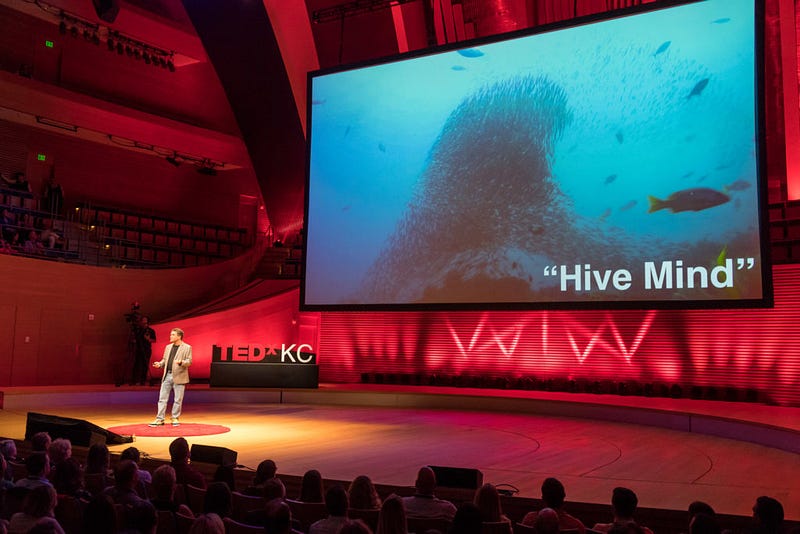
Rosenberg talking about biological hive minds in 2017 (video TEDx Kansas City)
In fact, many social species have evolved naturally in this direction, developing the ability to make rapid real-time decisions in large groups that greatly exceed the brainpower of individual members. Biologists call this Swarm Intelligence and it enables schools of fish, swarms of bees, and flocks of birds to quickly make life-and-death decisions at intelligence levels that far exceed the mental capacity of their individual minds.
One remarkable form of Swarm Intelligence that has inspired our academic research at Unanimous AU over the last decade is the fish school. Although it looks simple on the surface, the inner dynamics enable thousands of members to make complex decisions with no individual in charge. In fact, fish schools can make good decisions even when no single member has sufficient information to address the problem at hand. Consider the image below:
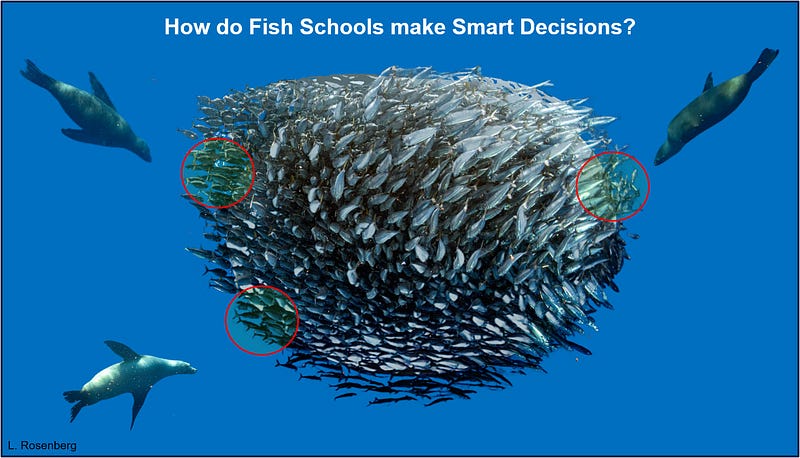
A fish school is a large organization with thousands of members and difficult problems to solve
The school above faces a hypothetical problem of extreme importance — three predators approach from three different directions. At the moment shown, no individual is aware of all three threats. In fact, most are not aware of any threats. There is a small group of fish in the upper left that is aware of the first predator, a small group in the lower left that is aware of the second predator, and a small group in the upper right that is aware of the third predator. Most of the other fish are unaware of the dangers.
So, how can a large group, in which all members have limited information (and no members possess all the information) solve this life and death problem and quickly move in the right direction? The first thing to know is that fish have a special organ on the sides of their body called the lateral line that allows them to track the speed and direction of neighboring fish based on pressure and vibrations in the water around them. Using this organ, they can perceive the intent of their neighbors (i.e., the speed and direction those fish believe the school should go). This communication is bidirectional so we can think of it as a local deliberation in which small groups decide the motion of their portion of the school.
This is interesting but does not explain how global decisions are made. After all, the group on the right that sees a predator approaching, likely decides the school should move left. At the same time, the two groups on the left likely decide the school should move right. And groups in the middle, which have no knowledge of the predators, are likely to keep moving in the direction they were already going. So, how does this get resolved into a single rapid decision that evades the urgent threats?
The magic happens because every fish in the school “deliberates” with a different group of nearby neighbors. This means there are many “overlapping conversations” happening at once which enables information to quickly propagate across the full school. As shown below, the result is a swift and decisive collective decision.
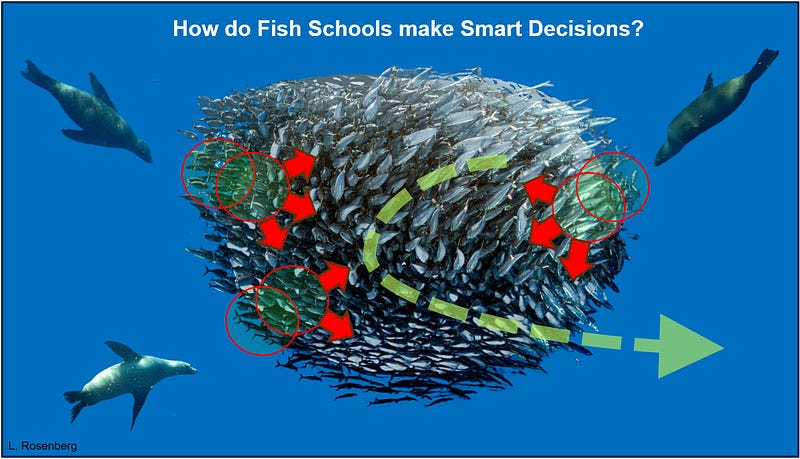
Fish Schools Make Rapid Smart Decisions
In this way, schooling fish can make rapid and effective decisions across large populations, even when all members have limited information. Such a skill would be even more powerful for large human groups. After all, the problems faced by groups of people are significantly more complex and involve far more perspectives. This begs the question — could large human groups deliberate in real-time with the efficiency of fish schools and quickly reach optimized decisions?
For years this goal seemed impossible. That’s because conversational deliberations have been shown to be most productive in small groups of 4 to 7 people and quickly degrade as groups grow larger. This is because the “airtime per person” gets progressively squeezed and the wait-time to respond to others steadily increases. By 12 to 15 people, the conversational dynamics change from thoughtful debate to a series of monologues that become increasingly disjointed. By 20 people, the dialog ceases to be a conversation at all. This problem seemed impenetrable until Unanimous AI combined the power of Swarm Intelligence with the flexibility of Generative AI.
The resulting technology is called Conversational Swarm Intelligence and it promises to allow groups of almost any size (200, 2000, or even 2 million people) to discuss complex problems in real-time and quickly converge on solutions with significantly amplified intelligence. The first step is to divide the population into small subgroups, each sized for thoughtful dialog. For example, a 1000-person group could be divided into 200 subgroups of 5, each routed into their own chat room or video conferencing session. Of course, this does not create a single unified conversation — it creates 200 parallel conversations.
As described above, fish schools solve this problem by having local groups overlap, allowing information to quickly propagate across the full population. Unfortunately, we humans did not evolve with the ability to be in multiple conversations at once. In fact, if we try to pay attention to two conversations, we immediately get confused and can’t focus on either. This is commonly called the “cocktail party problem” because it happens often when small groups gather within earshot of each other. If you try to pay attention to a neighboring conversation you immediately lose track of the discussion you are in.
So how can we overcome this human limitation?
The technology of CSI solves this problem by inserting LLM-powered “Conversational Surrogate Agents” into each subgroup. These AI agents are tasked with distilling the real-time human insights within its group and sharing those insights with Surrogate Agents in one or more other groups. The receiving agents express the insights inside their own groups as natural first-person dialog. In this way, each subgroup is given an artificial member that participates seamlessly in the conversation while ensuring information freely propagates across the full population.
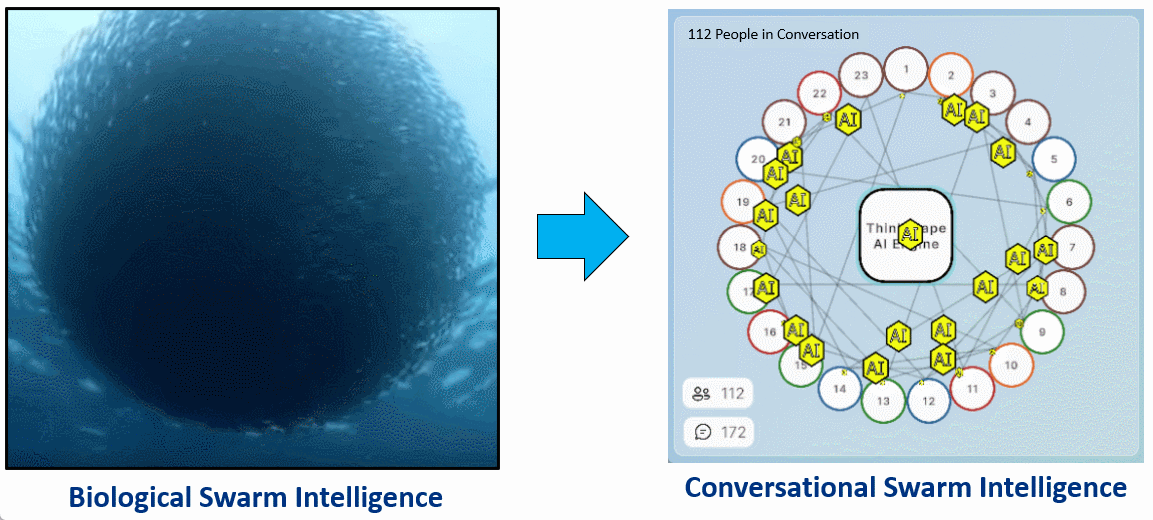
A variety of recent studies suggest the approach is effective. For example, a 2023 study was conducted at Carnegie Mellon University to compare real-time deliberations among approximately 50 people in traditional chatrooms versus conversational swarms in our new Thinkscape software platform powered by CSI. When using Thinkscape, human groups with interconnected conversational agents were able to hold more coherent conversations that quickly converged on solutions. In addition, each individual was found to contribute 50% more content (on average) than participants using traditional methods. Other studies have shown that 83% of users prefer holding discussions in Thinkscape over traditional chat environments.
But does this amplify group intelligence?
To explore this, a 2024 study by researchers at Carnegie Mellon and Unanimous AI tested the ability of networked groups to take IQ tests as a deliberative “hive mind.” Results showed that groups of 35 people, who averaged an IQ of 100 (the 50th percentile), could score an effective IQ of 128 (the 97th percentile) when using a CSI platform called Thinkscape. Although this study used conversational groups of only 35 participants, other recent studies have tested groups up to 250 with success.
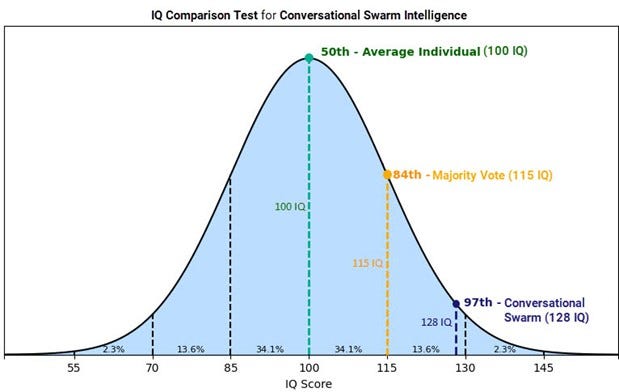
Read the full academic study here
While the above studies used text conversations, the core methods of CSI can be deployed for voice or video meetings, enabling groups of potentially any size to hold coherent real-time conversations that facilitate problem solving and amplify group intelligence. The technology is also scalable, able to extend not just to hundreds of individuals but thousands and potentially millions, all in real-time. This has the potential to enhance a wide range of fields from enterprise collaboration and market research to civic engagement and deliberative democracy.
In addition, recent research by my team at Unanimous AI has enabled large human groups to answer questions in through a unified personified avatar (which I call a pluribus avatar) that expresses the collective sentiment of the group in real-time. This can enable you, for example, to interview a thousand people in real-time, as if holding a conversation with collective.
Here is an example that was recently done using Thinkscape with 113 randomly selected members of the public. The group was asked to hold a real-time conversational deliberation about whether the U.S. should build new nuclear power plants. The first step was to ask the group the discuss their concerns regarding nuclear energy. After only six minutes of debate among the randomly selected participants, the AI-powered system produced this real-time representation of the group’s collective sentiment:
In the longer term, this approach could be used at extremely large scale to create a Collective Superintelligence that can solve our most difficult problems while remaining inherently aligned with human values, morals, wisdom, and sensibilities. In theory, we could use CSI technology to enable millions of individuals to “think together” as a global brain-of-brains.
And of course, in the mean-time the technology of Conversational Swarm Intelligence has been deployed in the Thinkscape platform for use by large teams (up to 400 people) for real-time brainstorming, discussions, debates, and problem solving. Thinkscape has also revolutionized market research by enabling focus groups of up to 400 people at a time, providing qualitative insights at statistical scale. For the first time, market researchers have been quickly generating qualitative insights they can trust to be repeatable!
For commercial use, see our Thinkscape® platform for bringing Collective Superintelligence to enterprise.
For government use, see our Project MindMeld™ aimed at bringing Collective Superintelligence to defense applications.


